Gain a fresh perspective on biblical narratives, exploring the often overlooked intersex figures and their significance in ancient texts.
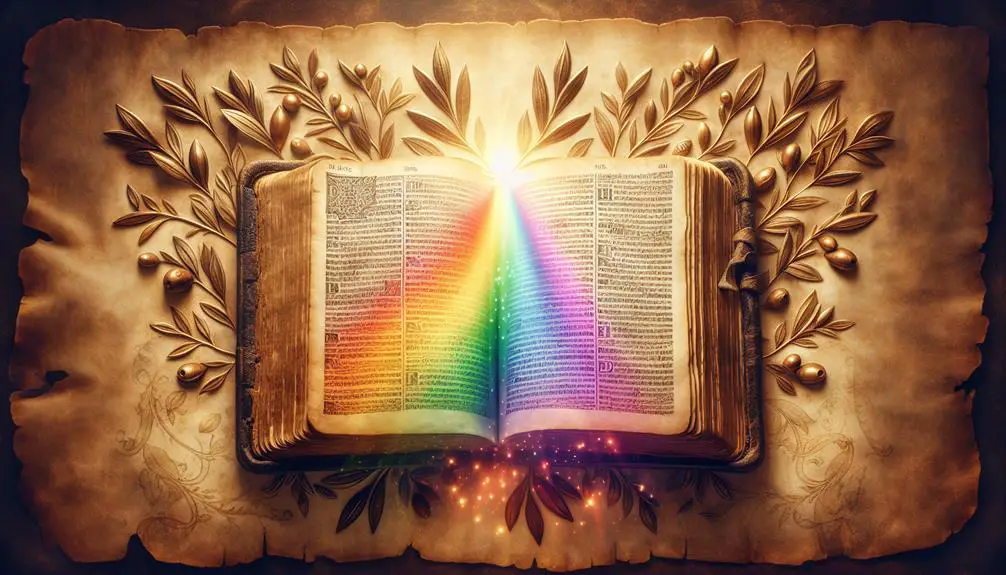
Intersex in the Bible
Just as a tapestry is woven from a myriad of colored threads, the Bible's narrative is complex and layered, particularly when you explore topics like intersexuality.
You've likely encountered the creation stories and laws, but have you considered the subtler shades of gender fluidity and the presence of intersex figures within these ancient texts?
The Bible's language and cultural context offer a rich field for exploration, where traditional interpretations may not always align with modern understandings of gender and sex.
By examining these texts anew, you'll uncover insights that challenge conventional views, inviting a deeper conversation about inclusivity and diversity in biblical times.
Key Takeaways
- Biblical texts, including creation stories, subtly recognize intersex identities through nuanced language and reinterpretations.
- Eunuchs in biblical narratives challenge traditional gender roles, hinting at a broader understanding of gender diversity.
- Scholarly analysis of ancient texts reveals instances of gender fluidity, supporting a spectrum of gender identities beyond the binary.
- Jesus' teachings and apostolic views advocate for inclusivity, challenging rigid gender norms and supporting gender diversity.
Understanding Biblical Language
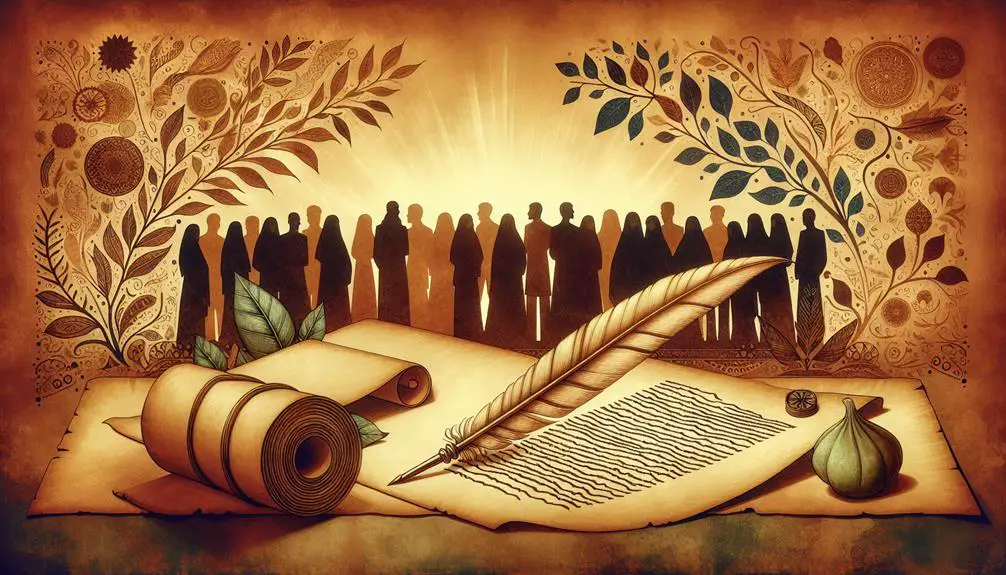
To fully grasp references to intersex individuals in the Bible, it's crucial to understand the nuances of biblical language and the historical context in which it was written. The Bible's language has undergone significant linguistic evolution over centuries, making direct translations challenging. Early biblical texts were written in Hebrew, Aramaic, and Greek, and each of these languages contains nuances that are often lost or altered in translation.
Cultural translations further complicate understanding. The societies in which these texts were written held different views on gender and sex than contemporary interpretations. Thus, when exploring references to intersex individuals, it's essential to consider the original terms used and the cultural contexts of those times. Modern translations may not accurately reflect the intended meaning, as they're influenced by the translator's cultural and linguistic background.
Analyzing biblical references to intersex individuals demands a scholarly approach, delving into ancient languages and understanding the societal norms of those periods. Only then can one appreciate the complexity and subtlety of these references beyond the face value of contemporary translations.
Creation Stories Revisited
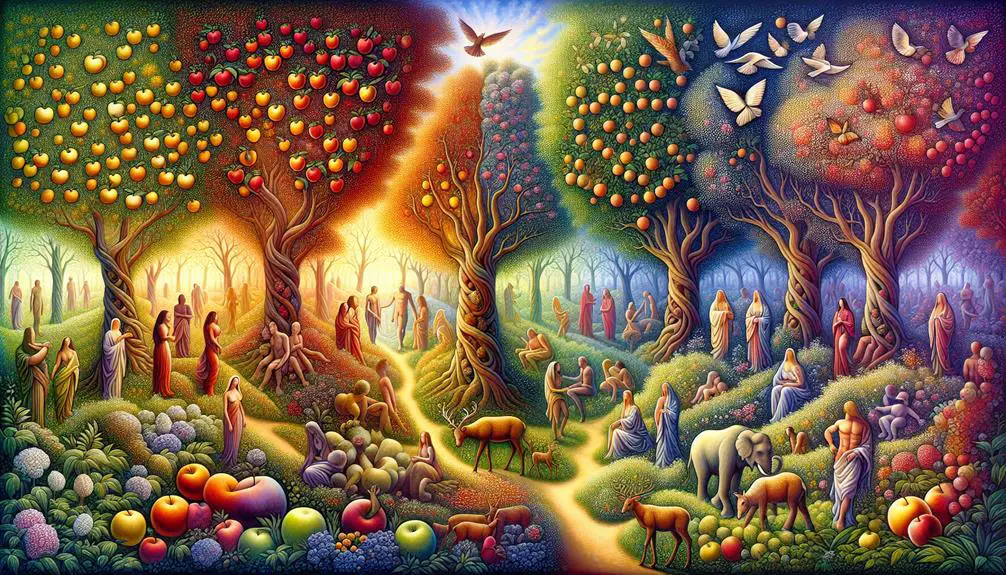
You'll find that revisiting the creation stories offers a nuanced perspective on Genesis diversity, challenging traditional interpretations.
By reimagining Adam's rib, you uncover layers of meaning that could suggest a broader understanding of gender.
This exploration into interpreting ancient texts invites a critical examination of how intersex identities might've been recognized or symbolized in biblical narratives.
Genesis Diversity Explored
Delving into Genesis, the creation stories present a rich tapestry of diversity that challenges traditional interpretations of gender and identity. This complexity isn't merely a product of theological inquiry but also intersects with cultural interpretations and scientific insights, offering a broader understanding of human identity that goes beyond binary classifications.
- Cultural Interpretations: Various cultures have understood these narratives in ways that embrace a spectrum of gender identities, suggesting a more inclusive reading of Genesis.
- Scientific Insights: Modern biology reveals the existence of intersex individuals, challenging a simplistic male/female dichotomy and reflecting the diversity inherent in creation.
- Theological Implications: These insights necessitate a reevaluation of traditional dogmas, advocating for a theology that acknowledges and celebrates the full spectrum of human existence.
Adam's Rib Reimagined
Reflecting on the Genesis diversity explored, we now turn our attention to a reinterpretation of Adam's rib, a narrative that further challenges conventional views on gender roles and origins in biblical texts. This reimagining introduces a complex layer of surgical symbolism and rib symbolism, inviting you to see beyond literal interpretations.
Symbolism |
Interpretation |
|---|---|
Surgical |
Represents divine intervention and creation, suggesting a meticulous and caring process rather than a simple act. |
Rib |
Symbolizes not just the physical aspect of human creation but also the inherent connectedness and equality between genders. |
This perspective enriches our understanding of creation stories, emphasizing inclusivity and the shared origins of humankind, challenging traditional binary views on gender and opening the door to a more nuanced interpretation of biblical narratives.
Interpreting Ancient Texts
In reassessing ancient texts, particularly creation stories, we encounter a rich tapestry of narratives that challenge our conventional understanding of gender and origin. Through textual criticism, we meticulously examine these ancient writings to uncover their intended meanings and assess their historical accuracy. This approach reveals:
- Varied Interpretations: Different cultures and translators have understood these texts in diverse ways, influencing our perception of gender roles and identities.
- Contextual Understanding: Historical and cultural contexts play a crucial role in interpreting these stories, offering insights into the societal norms of their times.
- Evolving Narratives: As societies evolve, so do interpretations of these texts, reflecting changing attitudes towards gender and identity.
This analytical journey through textual criticism underscores the complexity and fluidity of interpreting ancient creation stories, challenging us to rethink traditional narratives about gender and origin.
Laws and Eunuchs
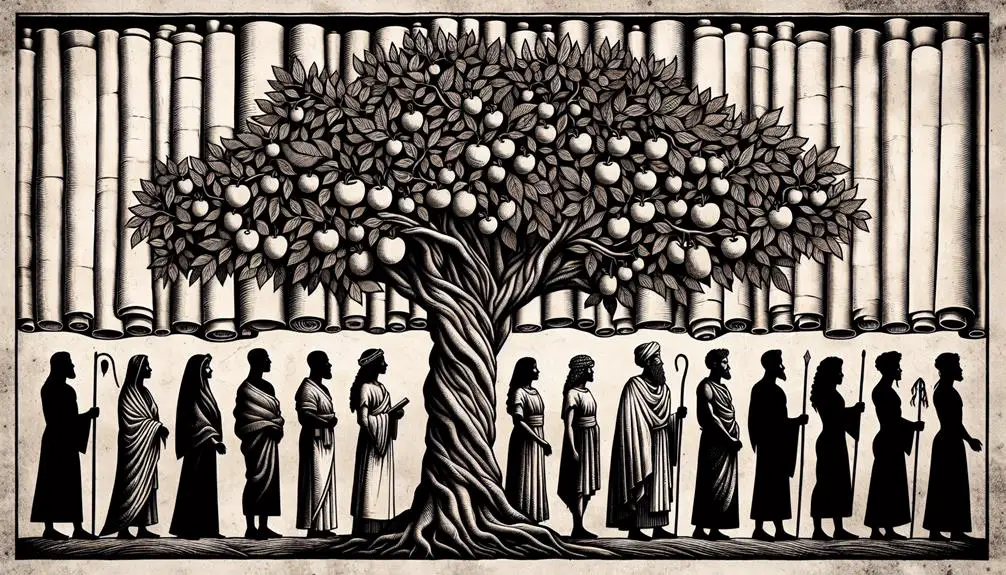
As you explore the intersection of laws and eunuchs in biblical texts, you'll uncover how eunuch identities were shaped by ancient laws and societal norms.
This analysis reveals the nuanced roles eunuchs played within sacred contexts, challenging modern interpretations of gender and sexuality in religious scripture.
Understanding these dynamics offers insight into the complex relationship between gender identity and religious law in ancient times.
Biblical Eunuch Identities
Throughout biblical texts, eunuchs hold a complex identity, shaped by specific laws and societal roles that merit close examination. Their presence isn't merely historical; it carries deep symbolism and has modern implications for understanding gender and sexuality within a religious context.
Here's a closer look at their significance:
- Eunuch symbolism represents both marginalization and unique service within biblical stories, illustrating how societal roles evolve.
- The inclusion of eunuchs challenges traditional gender roles, offering a broader spectrum of identity that resonates with modern discussions on gender fluidity.
- Their roles in biblical narratives provide valuable insights into the intersection of religious law, societal norms, and individual identity, encouraging a reevaluation of contemporary interpretations of sacred texts.
Ancient Laws Context
Delving into ancient laws reveals how eunuchs were intricately defined and regulated, shedding light on their complex roles within biblical societies. These laws, often grounded in the societies' moral and purity codes, positioned eunuchs uniquely, sometimes on the margins, other times within privileged precincts of power.
Yet, modern interpretations of these ancient statutes frequently encounter the challenge of cultural biases, which can obscure our understanding of their original context and significance. It's crucial to approach these texts with a critical eye, recognizing that contemporary perspectives may inadvertently color our readings.
This analytical process demands a careful separation of our modern biases from the historical realities of the time, ensuring a more accurate comprehension of the nuanced positions eunuchs held in biblical narratives.
Eunuchs' Sacred Roles
Eunuchs played pivotal roles in religious ceremonies and sacred rituals, reflecting a nuanced understanding of gender and divinity within ancient biblical societies. Their positions, often of significant trust and authority, highlight a sophisticated grasp of identity that challenges modern perspectives. This historical context invites a reevaluation of contemporary views on gender, particularly considering the surgical implications of becoming a eunuch.
- Trust and Authority: Eunuchs' roles in sacred spaces signified trust, elevating their status beyond societal norms.
- Gender Understanding: Their acceptance underscores a complex perception of gender, pre-dating current binary classifications.
- Surgical Implications: The process of becoming a eunuch, voluntary or otherwise, introduces discussions on bodily autonomy and the intersection of faith and physical transformation.
Gender Fluidity in Texts
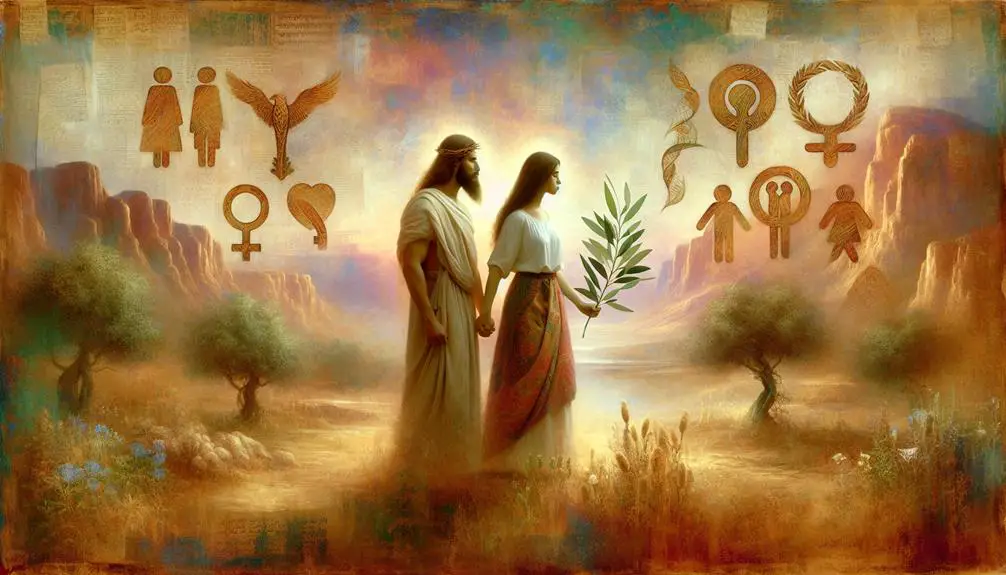
While ancient texts often reflect the gender norms of their times, a closer analysis reveals instances of gender fluidity that challenge traditional binary perspectives. Modern interpretations of these texts, when viewed through the lens of contemporary gender studies, illuminate how cultural perceptions of gender have evolved. You'll find that the rigid gender roles depicted aren't as fixed as once thought. Instead, there's an underlying complexity that speaks to a spectrum of gender identities, even if not explicitly labeled as such by the original authors.
This scholarly exploration into gender fluidity within sacred texts invites you to consider how interpretations are shaped by the cultural and historical context of both the reader and the period in which the text was written. It's a reminder that the binary gender framework is a relatively modern construct, not universally applicable across time and cultures. The fluidity found in these texts challenges you to rethink gender norms and consider the diversity of human experience. This analysis not only deepens our understanding of ancient narratives but also encourages a more inclusive approach to reading and interpreting sacred texts in the present day.
Intersex Figures and Allusions
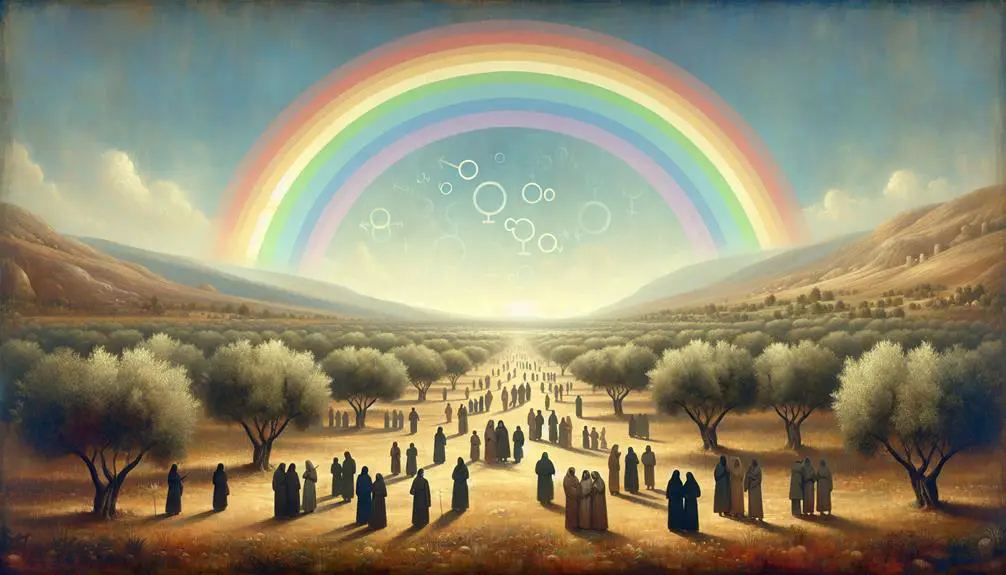
In exploring the biblical narrative, you'll encounter figures and allusions that suggest a recognition of intersex individuals, challenging the conventional binary understanding of gender. These references, though subtle and open to interpretation, offer a window into the ancient world's understanding of gender diversity that contrasts sharply with later, more rigid classifications.
Here are three key points to consider:
- Modern interpretations of biblical texts reveal a nuanced understanding of gender that includes, rather than excludes, intersex individuals. Scholars argue that certain passages, when read with an awareness of intersexuality, suggest a broader spectrum of gender identities than traditionally acknowledged.
- Cultural perceptions of gender in biblical times weren't static but evolved, reflecting the complexities of human identity. This fluidity in gender perception provides a historical context for the presence of intersex figures in sacred texts, indicating a societal awareness and, to some extent, acceptance.
- The translation and interpretation of biblical texts have historically been influenced by the cultural biases of the translators. This has led to a predominantly binary reading of gender, potentially overlooking references to intersex individuals and their experiences in the biblical narrative.
These points underscore the importance of revisiting ancient texts with a contemporary understanding of gender, shedding light on the historical presence and recognition of intersex individuals.
Jesus and Gender Diversity
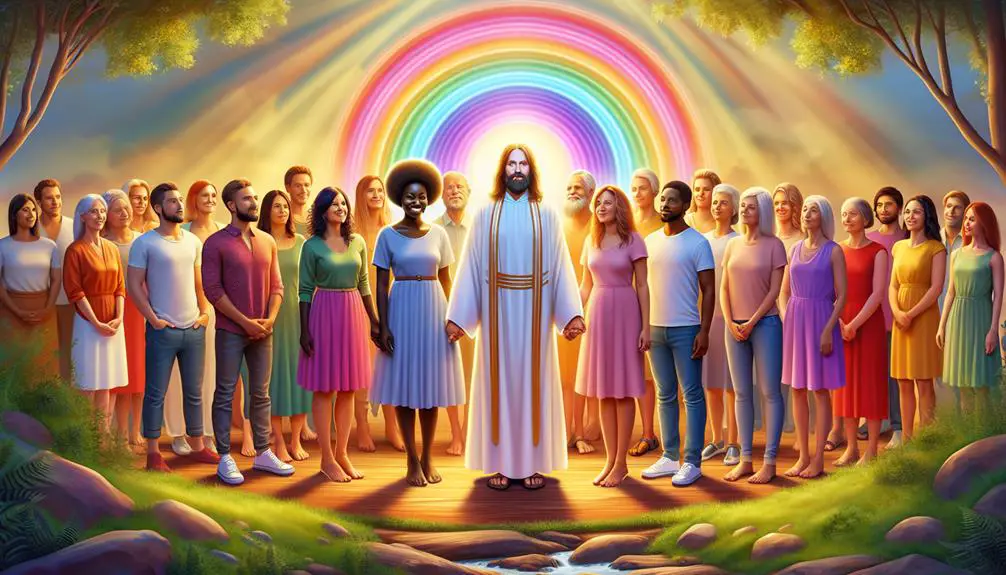
Building on the understanding of gender diversity in biblical texts, it's critical to explore Jesus's interactions and teachings that reflect a nuanced approach to gender. You'll find that Jesus' teachings often transcend traditional gender roles, aiming for inclusivity and understanding. For instance, His interactions with women, such as the Samaritan woman at the well, showcase a disregard for societal norms and a focus on the individual's faith and character.
Moreover, Jesus' teachings on eunuchs in Matthew 19:12 provide a direct reference to gender diversity, suggesting a recognition and acceptance of individuals outside the binary gender norms of His time. This acknowledgment is profound, considering the historical and cultural context in which it was made.
The Apostolic views, as reflected in the writings of Paul and others, further illuminate the early Christian approach to gender diversity. Paul's statement in Galatians 3:28, 'There is neither Jew nor Greek, slave nor free, male nor female, for you're all one in Christ Jesus,' underscores a radical inclusivity that challenges rigid gender categorizations.
Analyzing these aspects, it's apparent that Jesus' teachings and the Apostolic views collectively encourage a more inclusive understanding of gender, which has significant implications for contemporary discussions on gender diversity within Christian communities.
Interpretive Challenges and Perspectives
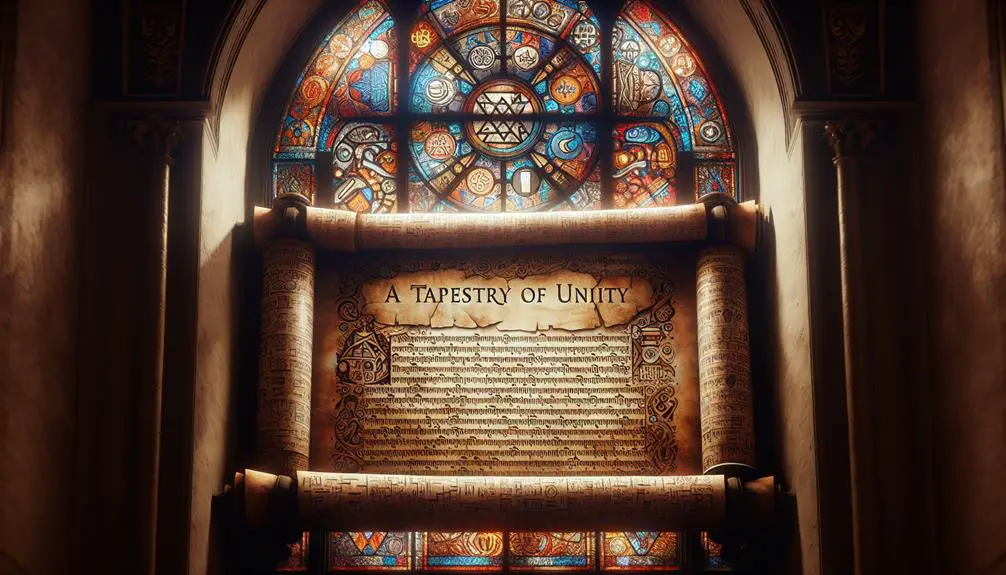
Navigating the interpretive landscape of biblical texts presents a complex challenge, particularly when examining perspectives on gender diversity. You confront a myriad of cultural biases that have historically influenced the understanding of these ancient texts. Recognizing these biases is crucial for a more inclusive interpretation that respects the diversity of human experiences.
To delve deeper, consider the following:
- Historical Context: The societal norms and cultural practices of ancient times significantly differ from today's world. Understanding the historical context of biblical passages is essential to avoid anachronistic interpretations that impose modern values on ancient texts.
- Translation and Interpretation: Every translation carries the translator's biases and perspectives. Analyzing different translations and interpretations can reveal how cultural biases have shaped our understanding of gender diversity in biblical texts.
- Modern Implications: The way we interpret these texts has profound implications for contemporary discussions on gender identity and inclusivity. Acknowledging the diversity present within biblical narratives can challenge prevailing gender norms and offer support for a more inclusive interpretation of religious teachings.
Frequently Asked Questions
How Do Contemporary Religious Scholars Reconcile Traditional Interpretations of Gender in the Bible With Current Understandings of Intersex Individuals?
You're exploring how religious scholars bridge traditional biblical gender views with modern insights into intersex people. They delve into historical accuracy, scrutinizing ancient texts to understand past perspectives.
Simultaneously, they apply ethical interpretations, acknowledging contemporary values and scientific knowledge. This approach allows them to reinterpret sacred writings in a way that respects both tradition and the existence of intersex individuals, aiming for a more inclusive understanding of gender in religious contexts.
Are There Specific Biblical Passages That Have Been Reinterpreted in Recent Years to Be More Inclusive of Intersex Identities?
Yes, you've hit the nail on the head. Scholars have revisited certain passages, weaving ancient terminologies with modern interpretations to foster inclusivity.
This analytical journey uncovers how texts, once rigid in gender views, now embrace intersex identities through scholarly, objective lenses. By dissecting words and contexts anew, they've shed light on the fluidity of identity, illustrating that biblical understanding evolves as society's grasp of gender and identity broadens.
How Do Different Christian Denominations Vary in Their Acceptance and Recognition of Intersex Individuals Based on Biblical Texts?
You'll find that Christian denominations vary widely in their acceptance and recognition of intersex individuals, often reflecting broader denominational debates and church policy.
While some branches may interpret biblical texts in more inclusive ways, others adhere strictly to traditional interpretations, limiting acceptance.
This divergence stems from differing theological perspectives and interpretations of scripture, leading to a complex landscape of acceptance across the Christian faith.
What Role Do Translations and Cultural Contexts Play in Understanding References to Intersex and Gender Diversity in the Bible?
You're diving into how linguistic evolution and cultural shifts impact the interpretation of ancient texts.
It's crucial to understand that translations often reflect the biases and norms of their times, potentially altering original meanings. As cultures evolve, so does our comprehension of these texts, including discussions on gender diversity.
Analyzing these factors reveals the complexities in interpreting historical references, especially when considering topics not explicitly defined in ancient narratives.
How Do Intersex Individuals Themselves Relate to Biblical Narratives, and Are There Any Movements Within Christianity Led by Intersex People Advocating for Greater Recognition?
You're exploring how intersex individuals engage with biblical narratives, amid a notable silence on their experiences. Some have pioneered intersex theology, analyzing gaps and seeking inclusive interpretations. These efforts challenge traditional readings and foster movements within Christianity for acknowledgment.
This pursuit of recognition is critical, as intersex people navigate a scripture that hasn't explicitly addressed their existence, advocating for a broader, more inclusive understanding of divine creation.
Conclusion
In conclusion, while the Bible may not explicitly discuss intersex individuals in modern terms, its narratives and laws hint at a nuanced understanding of gender diversity. Consider that 1 in 1,500 to 2,000 births results in a visibly intersex condition, presenting a compelling image of diversity intrinsic to humanity. This statistic challenges us to reflect on biblical texts through a lens that acknowledges gender fluidity.
Analyzing these sacred texts with an open, scholarly approach reveals a complex, yet inclusive, perspective on gender diversity.


Sign up